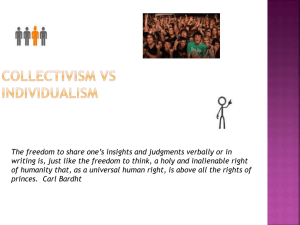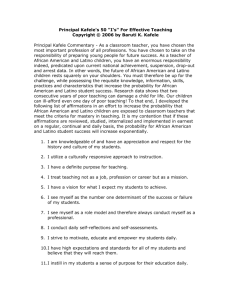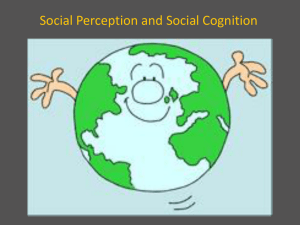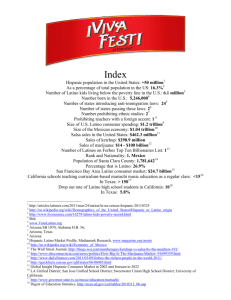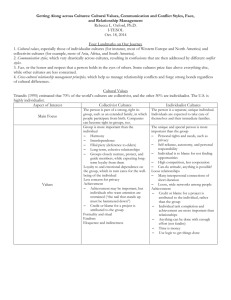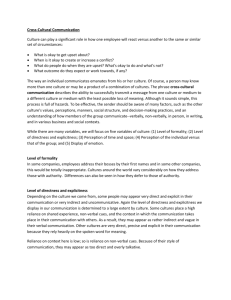Culture and Communication in the Workplace
advertisement
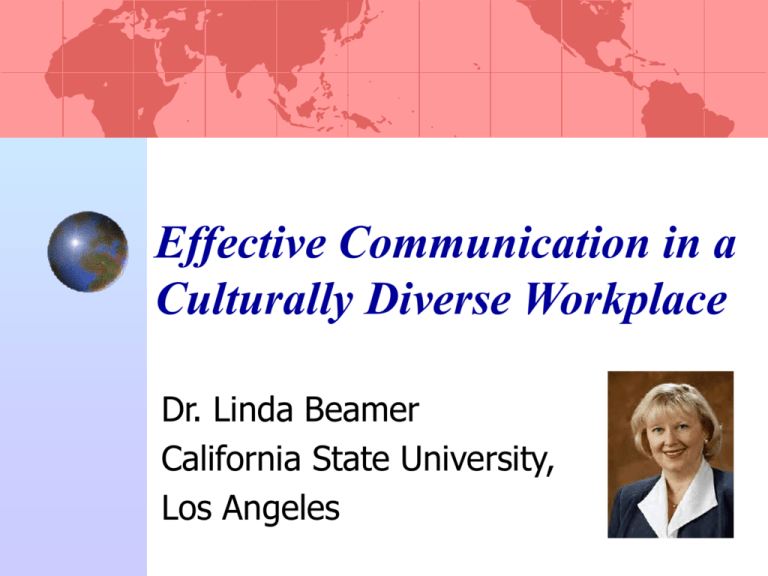
Effective Communication in a Culturally Diverse Workplace Dr. Linda Beamer California State University, Los Angeles Understanding Unfamiliar Cultures Using a culture-general approach Values orientation Behavior comparison Overcoming Bias and Stereotypes the threat of the unknown the comfort of the familiar Communicating with Strangers We operate on our own cultural assumptions range of what is “normal” is culturally based expectations may be limited Discomfort occurs when we encounter the unfamiliar and unexpected nonverbal communication differs level of personal disclosure differs formality/informality of language Typical responses Dimensions of Culture Individualist vs. collectivist Horizontal vs. hierarchical Form distrusted vs. form trusted Self in control vs. Other in control Learn from experience vs. from authority Rules-observant vs. rules-bending Communication direct vs. indirect Uncertainty-tolerant vs. uncertainty-averse Individualist vs. Collectivist Individualist cultures: Value independence for each individual Decision-making about one’s own affairs is left to the individual Accomplishments are credited to the individual Milestones in reaching one’s goals are important Overcoming obstacles on one’s own is valued Collectivist cultures: Value the group as the basic unit, and the individual as a fraction of a whole Membership in the group is important Membership means decision making is done by the collective Membership means accomplishments are collective Horizontal vs. Hierarchical Hierarchical cultures: value status and rank those at the top are not challenged or questioned those at the top are responsible for outcomes those at the top often have a responsibility for nurturing those below Horizontal cultures: have fewer ladders shared responsibility many contributors to the decision-making (Isn’t this collectivist? No, because…) input is considered valid when it comes from many sources throughout an organization flatter structure equalizes individual responsibility and opportunity Form Trusted vs. Suspect When form is trusted: the rules of “correct” behavior are known to all: Risk of making a faux pas is slight Social errors can make the group as well as the individual look untrustworthy, immature Personal and group face can be protected Comfort level is high for those who know the rules Where form is suspect: Lack of authenticity is disparaged Phoniness must be revealed and rejected if individuals can present themselves by their own words and deeds, being authentically who you say you are is important rules of behavior can camouflage the actual person False representation may be admired when it succeeds Self in Control vs. “Other” in Control When the self is in control of events: the self also is responsible for outcomes planning carefully becomes important to avoid unplanned results strategy and strategic thinking results tactics to achieve strategies are valued freedom is closely related to control control is closely related to independence and achievement When the “Other” is in control: Fate, Destiny, the Will of God explains outcomes Striving against the controlling power is folly piety may be valued spiritual and spirit-filled world view freedom results from letting go of control lack of order would result if the larger “other” were not taking charge Learning from experience vs.authority Learning from experience means: It isn’t true or learned until it is lived obstacles are turned into learning opportunities experiences can be viewed as successes Older persons have experienced more, and therefore are more learned Experiences that don’t teach something are wasted opportunities Hands-on learning is the most valuable kind Learning from authorities means: Teachers, authors, religious leaders, lecturers, etc. are the source of learning One learns by mastering their wisdom Personal experience is only fragmentary compared to the collected wisdom One learns by becoming aware of and storing mentally the insights of others Rules-observant vs. Rules-bending Rules-observant cultures: Believe it is good for people to follow laws equally expected of all keeps people from exploiting others View law breakers as negative Trust the law to ensure equality of opportunity, in spite of flawed implementation Rules-bending cultures: Expect to be able to make exceptions when status issues arise when inequalities of need are apparent for the sake of relationships See laws as inevitably impossible to apply in ways that ensure the good See their own ability to get around rules as a positively valued skill Direct vs. Indirect Communication Direct communication means: putting the main message up front preferring words that are unadorned, straightforward, and dynamic valuing the truth/facts over politeness “calling” people on their waffling or contradictions or ambiguity using bullets and point form avoiding contextual details Indirect communication means: delaying main messages until after details and explanations tolerating and enjoying ambiguity in word choice preserving and nurturing the relationship with others valuing the pleasant exchange more than objective truth relying heavily on context to communicate important meanings Uncertainty tolerant vs. averse Tolerating uncertainty means: less concerned about taking personal risks acceptance of challenges in new situations failure is not necessarily a huge disaster willingness to live without all the answers often responsibility lies with “other” and not with individual planning is not viewed as the cure-all for preventing problems Aversion to uncertainty means: tendency to plan in order to minimize the unknown tendency to play by the rules in work issues, especially regarding promotion desire to have clear lines of authority and responsibility in the workplace fear of failure fear of being in a risky situation where the outcome is unpredictable Asian Cultures Individualist collectivist Horizontal hierarchical Form distrusted trusted Self control Other control Learn from experience authority Rules-observant rules-bending Communication direct indirect Uncertainty-tolerant uncertaintyaverse Euro -American Culture Individualist collectivist Horizontal hierarchical Form distrusted trusted Self control Other control Learn from experience authority Rules-observant rules-bending Communication direct indirect Uncertainty-tolerant uncertaintyaverse African American Culture Individualist collectivist Horizontal hierarchical Form distrusted trusted Self control Other control Learn from experience authority Rules-observant rules-bending Communication direct indirect Uncertainty-tolerant uncertaintyaverse Latino Cultures Individualist collectivist Horizontal hierarchical Form distrusted trusted Self control Other control Learn from experience authority Rules-observant rules-bending Communication direct indirect Uncertainty-tolerant uncertaintyaverse Clusters of Cultures Collectivist Latino Individualist Latino Hierarchical African American Horizontal Latino Form trusted African American Form distrusted Latino Other in control African American Self in control Learn from Authorities Latino African American Learn from Experience Rules Observant African American Latino Rules Bending Communication Indirect Latino African American Communication Direct Latino Uncertainty-tolerant African American Uncertainty-averse What it Means for Communicating at Work African American workplace: Asian student: Communication problems likely to occur: about communication style, status, future Asian workplace: Latino student: Communication problems will occur less often: key values are similarly oriented Latino workplace: African American student: Communication problems likely about style of communicating, future, status and learning Euro American workplace: Latino student: Communication problems likely to occur: about many cultural values, communication style What We Can Do Become aware of the differences in values that constitute cultural dimensions Discern different communication styles and the concerns that generate them Understand your own cultural priorities and therefore your own probable biases Keep your communication clear, and aid your messages with graphics

